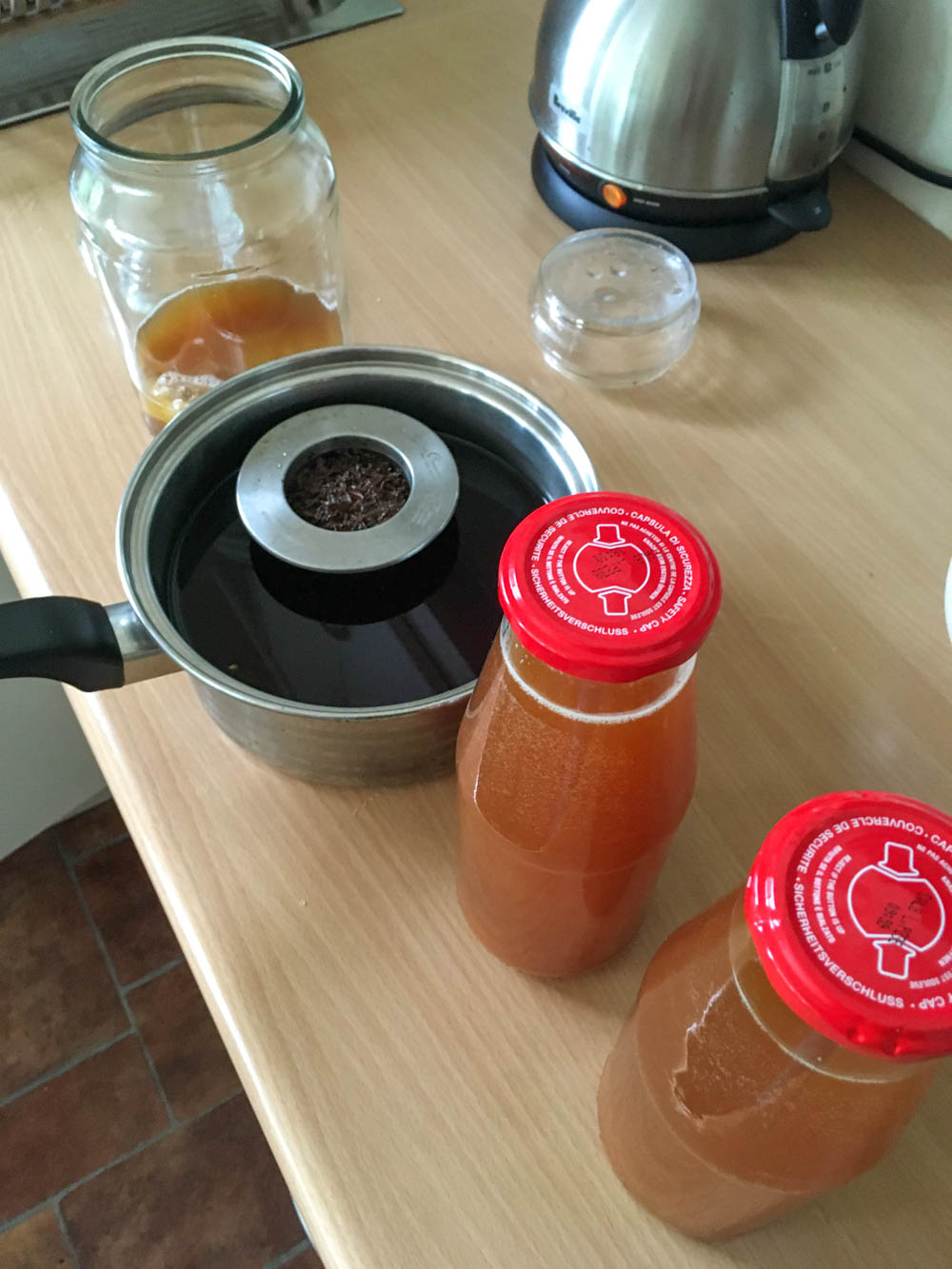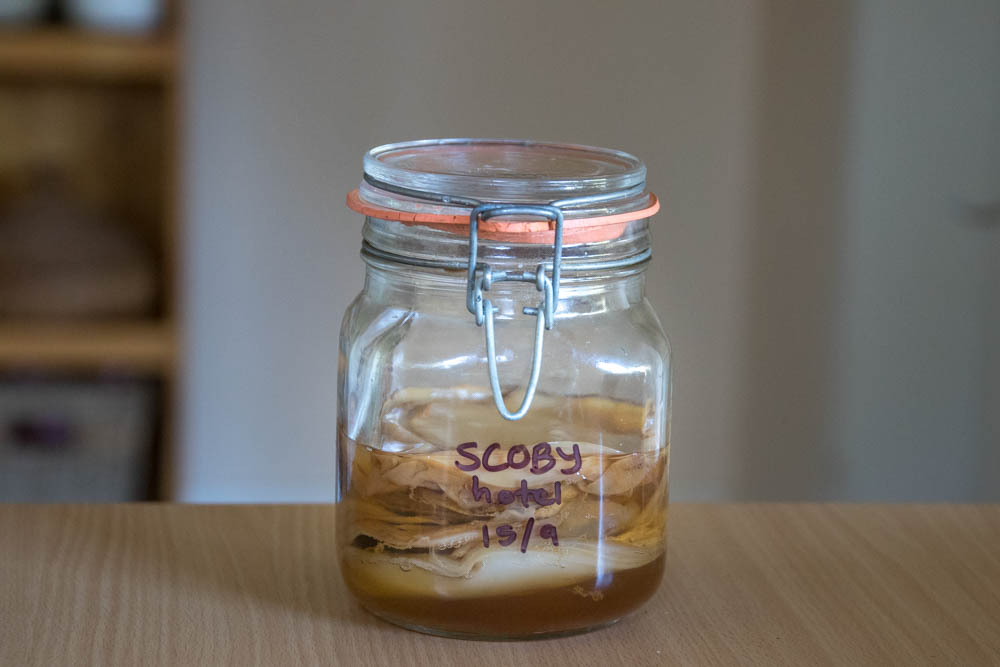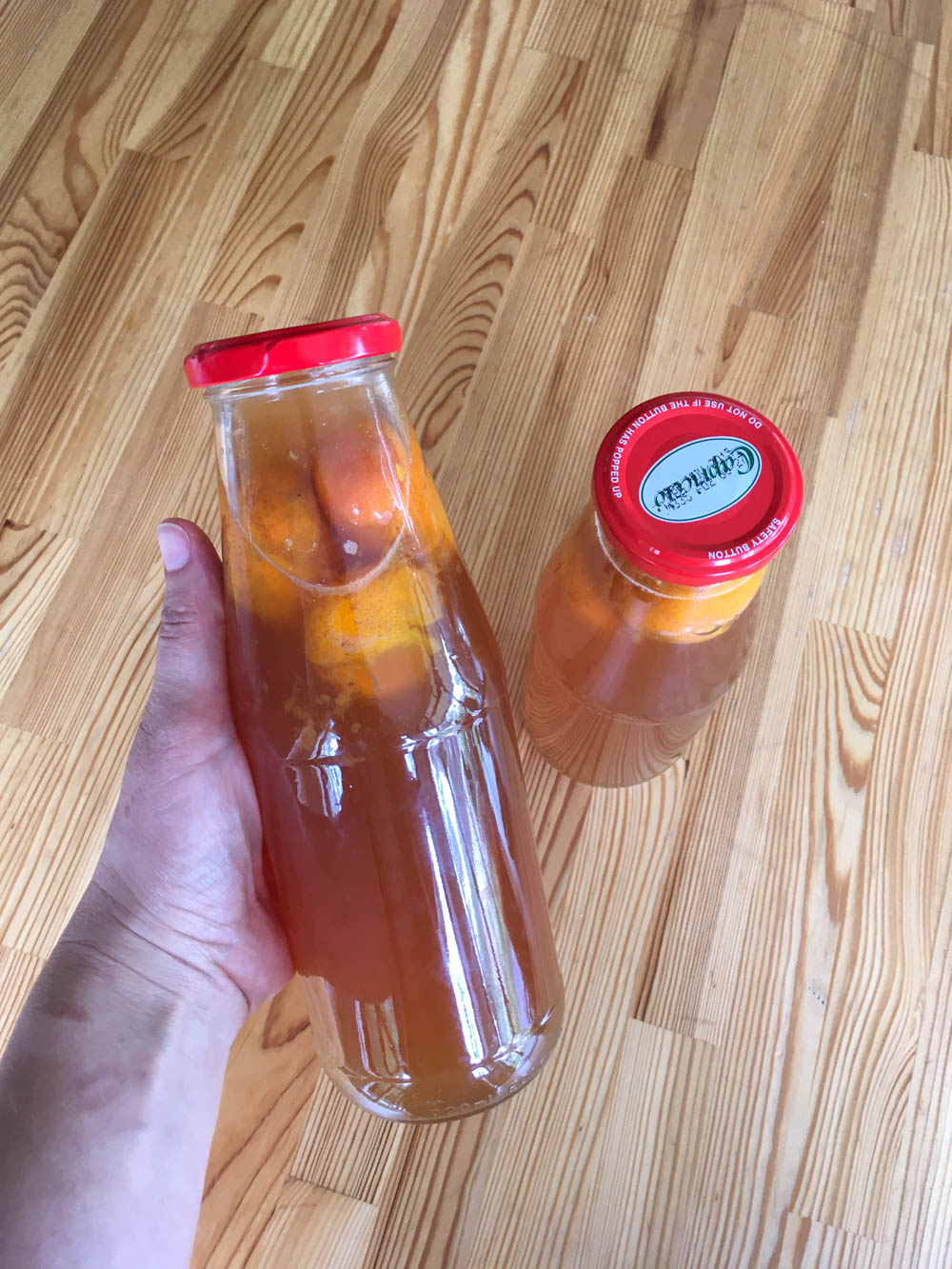
Kombucha is insanely easy to make at home once you have a SCOBY – a Symbiotic Culture Of Bacteria and Yeast. Aka: a weird disc-like, rubbery looking thing that floats at the top of your brew. It’s pretty freaky looking, to be honest.
I got my first SCOBY via the Zero Waste Adelaide Facebook group. A wonderful woman named Zoe spotted my post and promptly delivered a complete kombucha-making set, including jars, two SCOBY and starter liquid. Amazing!
A year on and I’m still making and drinking booch every week.

I’ve grown to love the process – keeping a culture alive and turning it into a gut-friendly drink, with just time, organic loose leaf tea, a little sugar and air. Magic, really.
There’s a few ways to make kombucha. Here’s what I found works for us…
Step 1: The first ferment
Step one is simple: you need only tea, sugar and a SCOBY.
The latter you can find from friends who already make kombucha, buy some online, or buy from us!

Tip: use loose leaf tea and source organic if you can. Tea bags are often filled with plastic fibres, meaning they can only go into landfill. And chemicals on tea leaves grown non-organically can slow down or otherwise affect your ferment. It’s a living beast, after all.
By tea, I mean an infusion made from the tea plant (Camellia sinensis), not the infusions of other plants (such as chamomile or mint) that in the English language we also describe as teas.
You may use black tea, green tea, white tea, kukicha, pu-er, or other styles of tea, but in general stay away from Earl Grey or other heavily flavoured or scented teas, as the added essential oils may inhibit fermentation.
Sandor Katz, The Art of Fermentation
Ingredients
3 litres rainwater (or filtered water)
1 cup cane sugar
4-5 generous tablespoons tea
1 SCOBY
½ cup of kombucha starter liquid from previous brew
Note: you can make more or less tea to fill the size of your jar, just adjust the sugar ratio accordingly.
Method
Boil the water and dissolve the sugar, then add the tea leaves. We use a saucepan for this step, along with a metal tea infuser like this one (reusable! yay!). Allow the water to completely cool. We leave the tea leaves in the water so it brews nice and strong.
We generally brew up a litre of strong tea, then add two litres of cold water once the original litre has cooled. Just easier for us, as otherwise the tea infuser tends to get submerge and you end up with tea leaves floating everywhere.

Grab a large jar. Old Moccona coffee jars or wide-mouth swing-top jars are great (and easy to find at op shops); whatever you use, it’s handy to remove the plastic or rubber seal so the booch can expel carbon dioxide easily while brewing. This way, you don’t have to manually ‘burp’ it by opening the lid regularly.
Plop your SCOBY in the jar with the starter liquid. Pour in your cooled sugary tea. Give it a quick mix.
Leave for anywhere from 4 to 10 days.
The length will depend both on the temperature of your house at the time and also your personal taste. Booch will ferment faster in warmer weather, while it will need more time and patience in winter. You also might prefer yours fairly sweet or a bit more vinegary. We check the brew by poking a reusable bamboo straw beneath the SCOBY and taking a sip.
Once it’s tasting good to you, you can either drink as is. Or, move onto a second fermentation to add yum additional flavours.
Either way, remember to reserve a little of the liquid to make your next batch.
Step 2: The second ferment – adding flavours
The second fermentation is optional, but it’s where you can have a lot of fun.
The basic theory is: add a little more sugar (of any description) to keep feeding the booch and combine with juices, herbs, fruits and anything else to add beautiful additional flavour.

Ingredients
For the sugar: Honey, fruit juice, dried fruit or a little extra sugar.
For the flavour: We try something different each time, but have particularly loved:
- Fresh mint, on its own or combined with almost anything else
- Pomegranate seeds or juice
- Strawberries and blackberries (the latter grow wild in the Adelaide Hills and are easy to forage in summer)
- Lemon balm
- Lemon verbena
- Elderberry syrup
- Figs
- Cumquats, oranges or lemon
- Cloves
- Star anise
Tip: dried fruit adds extra fizziness. Our friend Carla from Adelaide’s Wagtail Urban Farm recommends adding dried fruit to really power up the fizz. We tried this with nashi pears and peaches, gifted by friends and dried by us, and it worked amazingly well.
Method
Remove the SCOBY and set aside. Pour the kombucha liquid into bottles. Swing-top bottles are great (and can often be found in op shops). We used old passata bottles, repurposed.

Tip: strain the liquid to remove clumps of years. Sam from Folk of all Trades recommends straining the liquid through a strainer first, to help remove some of the stringy clumps of yeast. This can help prevent the booch going nuts in second fermentation and creating another SCOBY on top (although there’s no real drama if it does).
Add your chosen form of sugar – say, a teaspoon of honey, a quarter cup of juice, or a small handful of dried fruit. Also add your chosen herbs or fruit; again, a handful is about enough.
Screw the lid on tight. Write the date on the bottles and store in a dark cupboard.
Again, the fermentation length will depend a bit on how warm your house is and your own personal taste. But generally, a couple days to a week is long enough here. This is why we like the passata bottles, as we can press the seal button on each lid – when it’s fully expanded and won’t press in anymore, we know we’ve got a good fizz going.

At this point, you can pop the booch in the fridge to slow the ferment right down and safely keep it for a week or two.
Or, open it straight up, strain off the herbs and fruit, and drink! (Just go slow when opening, as a really fizzy ferment may bubble up and out, all over the place.)
YUM.

Storing extra SCOBY (aka: creating a SCOBY Hotel)
It’s always a good idea to have at least one extra SCOBY on hand in case something goes mouldy or funky with your primary ferment. You can safely turf the lot (and yes, you do need to ditch the entire batch) and start again fresh with your back-up.
Also, once you get into the habit of making booch regularly, you’ll notice that your SCOBY will continue to grow extra layers, which can be split off into their own beings.
These extra SCOBY are compostable, so you can simply pop them into your scrap bucket or green bin to dispose of them responsibly. (And some people make SCOBY candy, SCOBY fruit leather and even SCOBY dog treats!)
Or, you can create your own little SCOBY Hotel, where your spare SCOBY can all live together happily for months on end with absolutely no effort or action required on your part.

A hotel is a great option for if you need to pause making your booch for awhile. Just chuck the SCOBY in the hotel and you can forget about it, for a few months at least.
To make a SCOBY hotel (it’s simple):
- Pop all your SCOBY into a clean glass jar – as many SCOBY as you want, the sky’s the limit here.
- Cover them over with brewed kombucha or sweetened black tea. Either is fine, as is a mixture of both.
- Put the lid on, write the date on the jar, and place it in a cool dark cupboard (not the fridge).
- Check your hotel every three to six months. You can pour off the liquid, which will have turned to strong vinegar – great for using in cooking and cleaning – and refresh with more booch or black tea.
- Whenever you’re ready to start using a SCOBY, take it out of the hotel and start from Step 1 above.
Troubleshooting kombucha problems

The SCOBY looks weird / has mould growing on it: OK, so generally speaking, SCOBY just does look weird. But if it’s got anything that looks like mould, you’ll need to throw away the whole thing – liquid and SCOBY – and start again. Which is no big deal, because you have spare SCOBY in your hotel, right?
It’s not fizzy enough: You may have left it a little too long in primary fermentation stage. Or not added enough sugary stuff to the second fermentation. It doesn’t matter – it will still be yum to drink as is. Just tweak your inputs a little next time and try again.
It tastes like vinegar: You’ve definitely left it to ferment too long. But never fear, this stuff is still great to use! It’s amazing in salad dressings and chutneys, and can even be used alongside bicarb soda as a homemade green cleaner.
A SCOBY has formed atop my second ferment: Yeah, that can happen, often because there was lots of yeast in the bottle (see Sam’s tip above about straining the liquid before adding second ferment flavours). But it’s no big deal, just strain it off and drink as usual.
My glass container exploded! Holy chaos! This can happen if you try to brew your sugary tea straight into your glass jar; the heat will crack the glass. Better to brew in a metal saucepan, allow to cool and then add to your glass jar. Explosions can also sometimes happen if you let your booch get too fizzy during fermentation. ‘Burping’ your kombucha (releasing the lid for a second to let out excess gas, before closing up again), or placing your brew in the fridge, can help.

Phew, that got quite long! Hopefully that’s all helpful and wishing you good luck with your own brew. Please do let me know how you go – feel free to chuck any further questions in the comments below.
Oh, and if you’re keen to make your own but need a SCOBY to kick things often, we often have Kombucha Starter Kits available from our Adelaide honestly stall, The Local Yum.




